1997 MERCEDES-BENZ ML430 ignition
[x] Cancel search: ignitionPage 2176 of 4133
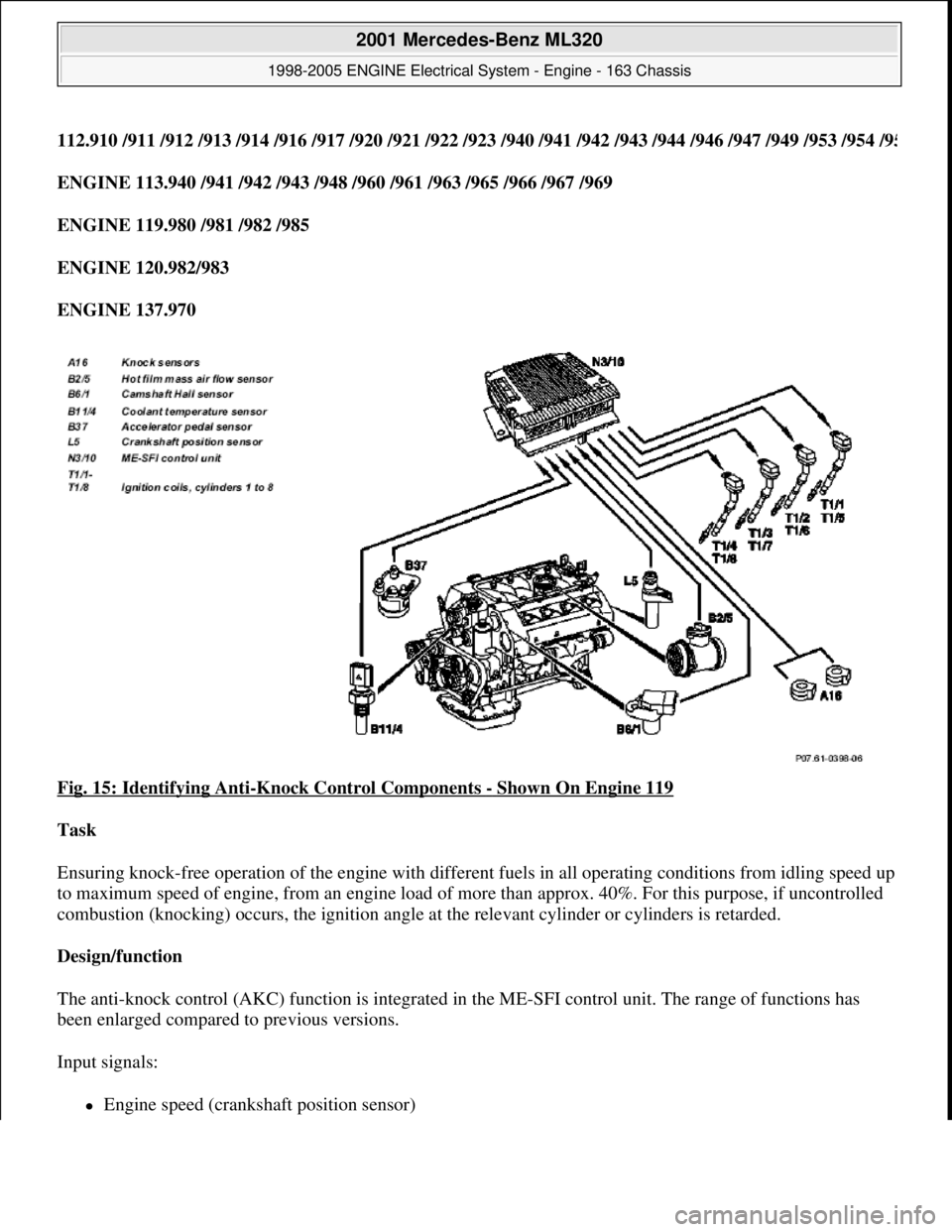
112.910 /911 /912 /913 /914 /916 /917 /920 /921 /922 /923 /940 /941 /942 /943 /944 /946 /947 /949 /953 /954 /95
ENGINE 113.940 /941 /942 /943 /948 /960 /961 /963 /965 /966 /967 /969
ENGINE 119.980 /981 /982 /985
ENGINE 120.982/983
ENGINE 137.970
Fig. 15: Identifying Anti
-Knock Control Components - Shown On Engine 119
Task
Ensuring knock-free operation of the engine with different fuels in all operating conditions from idling speed up
to maximum speed of engine, from an engine load of more than approx. 40%. For this purpose, if uncontrolled
combustion (knocking) occurs, the ignition angle at the relevant cylinder or cylinders is retarded.
Design/function
The anti-knock control (AKC) function is integrated in the ME-SFI control unit. The range of functions has
been enlarged compared to previous versions.
Input signals:
Engine speed (crankshaft position sensor)
2001 Mercedes-Benz ML320
1998-2005 ENGINE Electrical System - Engine - 163 Chassis
me
Saturday, October 02, 2010 3:18:54 PMPage 22 © 2006 Mitchell Repair Information Company, LLC.
Page 2177 of 4133
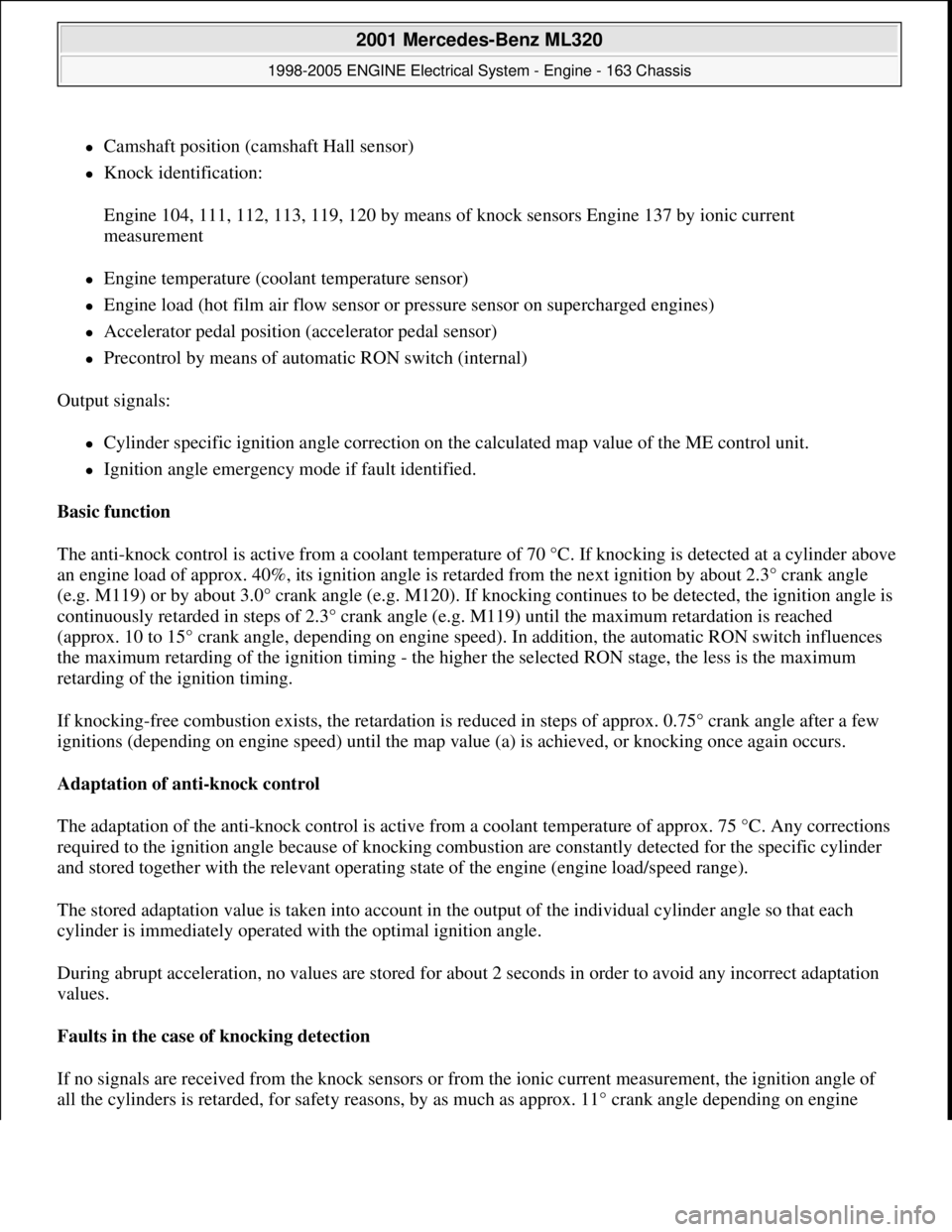
Camshaft position (camshaft Hall sensor)
Knock identification:
Engine 104, 111, 112, 113, 119, 120 by means of knock sensors Engine 137 by ionic current
measurement
Engine temperature (coolant temperature sensor)
Engine load (hot film air flow sensor or pressure sensor on supercharged engines)
Accelerator pedal position (accelerator pedal sensor)
Precontrol by means of automatic RON switch (internal)
Output signals:
Cylinder specific ignition angle correction on the calculated map value of the ME control unit.
Ignition angle emergency mode if fault identified.
Basic function
The anti-knock control is active from a coolant temperature of 70 °C. If knocking is detected at a cylinder above
an engine load of approx. 40%, its ignition angle is retarded from the next ignition by about 2.3° crank angle
(e.g. M119) or by about 3.0° crank angle (e.g. M120). If knocking continues to be detected, the ignition angle is
continuously retarded in steps of 2.3° crank angle (e.g. M119) until the maximum retardation is reached
(approx. 10 to 15° crank angle, depending on engine speed). In addition, the automatic RON switch influences
the maximum retarding of the ignition timing - the higher the selected RON stage, the less is the maximum
retarding of the ignition timing.
If knocking-free combustion exists, the retardation is reduced in steps of approx. 0.75° crank angle after a few
ignitions (depending on engine speed) until the map value (a) is achieved, or knocking once again occurs.
Adaptation of anti-knock control
The adaptation of the anti-knock control is active from a coolant temperature of approx. 75 °C. Any corrections
required to the ignition angle because of knocking combustion are constantly detected for the specific cylinder
and stored together with the relevant operating state of the engine (engine load/speed range).
The stored adaptation value is taken into account in the output of the individual cylinder angle so that each
cylinder is immediately operated with the optimal ignition angle.
During abrupt acceleration, no values are stored for about 2 seconds in order to avoid any incorrect adaptation
values.
Faults in the case of knocking detection
If no signals are received from the knock sensors or from the ionic current measurement, the ignition angle of
all the c
ylinders is retarded, for safety reasons, by as much as approx. 11° crank angle depending on engine
2001 Mercedes-Benz ML320
1998-2005 ENGINE Electrical System - Engine - 163 Chassis
me
Saturday, October 02, 2010 3:18:54 PMPage 23 © 2006 Mitchell Repair Information Company, LLC.
Page 2178 of 4133
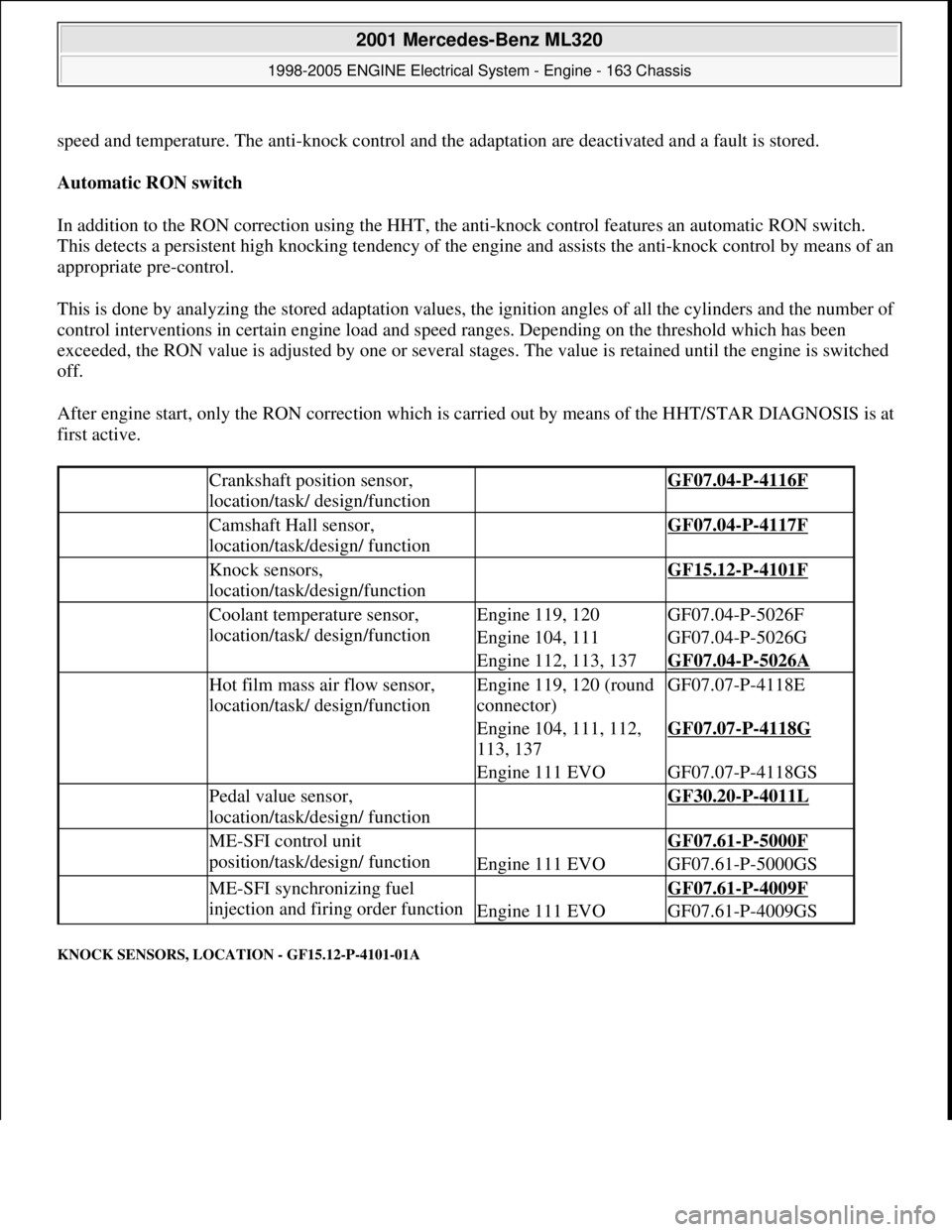
speed and temperature. The anti-knock control and the adaptation are deactivated and a fault is stored.
Automatic RON switch
In addition to the RON correction using the HHT, the anti-knock control features an automatic RON switch.
This detects a persistent high knocking tendency of the engine and assists the anti-knock control by means of an
appropriate pre-control.
This is done by analyzing the stored adaptation values, the ignition angles of all the cylinders and the number of
control interventions in certain engine load and speed ranges. Depending on the threshold which has been
exceeded, the RON value is adjusted by one or several stages. The value is retained until the engine is switched
off.
After engine start, only the RON correction which is carried out by means of the HHT/STAR DIAGNOSIS is at
first active.
KNOCK SENSORS, LOCATION - GF15.12-P-4101-01A
Crankshaft position sensor,
location/task/ design/function GF07.04-P-4116F
Camshaft Hall sensor,
location/task/design/ function GF07.04-P-4117F
Knock sensors,
location/task/design/function GF15.12-P-4101F
Coolant temperature sensor,
location/task/ design/functionEngine 119, 120GF07.04-P-5026F
Engine 104, 111GF07.04-P-5026G
Engine 112, 113, 137GF07.04-P-5026A
Hot film mass air flow sensor,
location/task/ design/functionEngine 119, 120 (round
connector)GF07.07-P-4118E
Engine 104, 111, 112,
113, 137GF07.07-P-4118G
Engine 111 EVOGF07.07-P-4118GS
Pedal value sensor,
location/task/design/ function GF30.20-P-4011L
ME-SFI control unit
position/task/design/ function GF07.61-P-5000F
Engine 111 EVOGF07.61-P-5000GS
ME-SFI synchronizing fuel
injection and firing order function GF07.61-P-4009F
Engine 111 EVOGF07.61-P-4009GS
2001 Mercedes-Benz ML320
1998-2005 ENGINE Electrical System - Engine - 163 Chassis
me
Saturday, October 02, 2010 3:18:54 PMPage 24 © 2006 Mitchell Repair Information Company, LLC.
Page 2183 of 4133

Task
After engine start speed is reached, interrupt the circuit (circuit 50) M1 to the solenoid switch of the starter.
Design
The solenoid switch of the starter is operated not through the ignition/ start switch S2/1, but in drive position P
or N through the starter relay, by the engine control unit.
The voltage for the starter relay (coil) is supplied through circuit 87. The starter relay is actuated by the engine
control unit through GND.
Function
When the ignition/start switch is operated in the start position, the engine control unit activates an automatic
start control. Once the engine start speed of 400 to 700 rpm is reached, the engine control unit interrupts the
ground actuation to the starter relay and thus the engine start operation.
Once the engine start operation is initiated, shutting off circuit 50 at the ignition/start switch has no effect. The
starter rotates until the specified start speed is reached, or for about 5 seconds at an engine temperature of +80 °
C, for a maximum of 10 seconds if the engine is cold.
SAFETY PRECAUTIONS
SAFETY INFORMATION: ELECTRICAL SYSTEM - ENGINE - AS15.00-Z-9999ZZ
MODEL all
Motor electronics control unit,
location/task/ design/function GF07.61-P-5000F
HFM-SFI control unit,
location/task/design/ function GF07.51-P-4103D
Crankshaft position sensor,
location/task/ design/function GF07.04-P-4116F
Start recognition functionEngine 104,, 111, 112,
113, 137 (via terminal 50)GF07.13-P-3014G
Engine 119, 120 (via
engine speed signal)GF07.13-P-3014F
ETC control unit, location/taskSelector lever position
information P/N and
driving position engaged.
Transmission 722.6GF27.19-P-4012G
Electronic ignition switch
control unit, location/
task/design/functionModel 202 as of 6/97, 208,
210 as of 3/97GF80.57-P-4102A
Model 215, 220GF80.57-P-4102S
Model 203, 209GF80.57-P-4102PP
2001 Mercedes-Benz ML320
1998-2005 ENGINE Electrical System - Engine - 163 Chassis
me
Saturday, October 02, 2010 3:18:54 PMPage 29 © 2006 Mitchell Repair Information Company, LLC.
Page 2184 of 4133
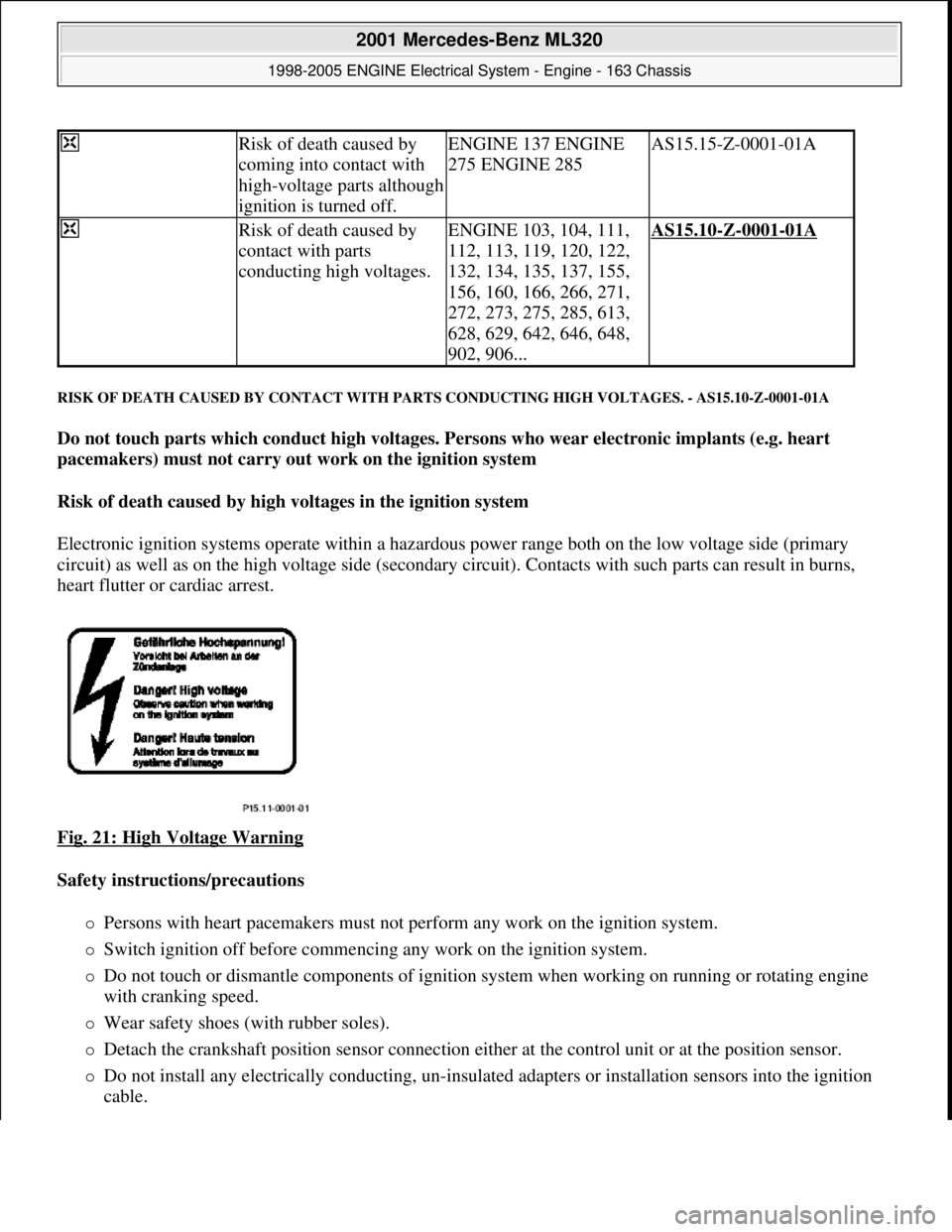
RISK OF DEATH CAUSED BY CONTACT WITH PARTS CONDUCTING HIGH VOLTAGES. - AS15.10-Z-0001-01A
Do not touch parts which conduct high voltages. Persons who wear electronic implants (e.g. heart
pacemakers) must not carry out work on the ignition system
Risk of death caused by high voltages in the ignition system
Electronic ignition systems operate within a hazardous power range both on the low voltage side (primary
circuit) as well as on the high voltage side (secondary circuit). Contacts with such parts can result in burns,
heart flutter or cardiac arrest.
Fig. 21: High Voltage Warning
Safety instructions/precautions
Persons with heart pacemakers must not perform any work on the ignition system.
Switch ignition off before commencing any work on the ignition system.
Do not touch or dismantle components of ignition system when working on running or rotating engine
with cranking speed.
Wear safety shoes (with rubber soles).
Detach the crankshaft position sensor connection either at the control unit or at the position sensor.
Do not install any electrically conducting, un-insulated adapters or installation sensors into the ignition
cable.
Risk of death caused by
coming into contact with
high-voltage parts although
ignition is turned off.ENGINE 137 ENGINE
275 ENGINE 285AS15.15-Z-0001-01A
Risk of death caused by
contact with parts
conducting high voltages.ENGINE 103, 104, 111,
112, 113, 119, 120, 122,
132, 134, 135, 137, 155,
156, 160, 166, 266, 271,
272, 273, 275, 285, 613,
628, 629, 642, 646, 648,
902, 906...AS15.10-Z-0001-01A
2001 Mercedes-Benz ML320
1998-2005 ENGINE Electrical System - Engine - 163 Chassis
me
Saturday, October 02, 2010 3:18:54 PMPage 30 © 2006 Mitchell Repair Information Company, LLC.
Page 2187 of 4133
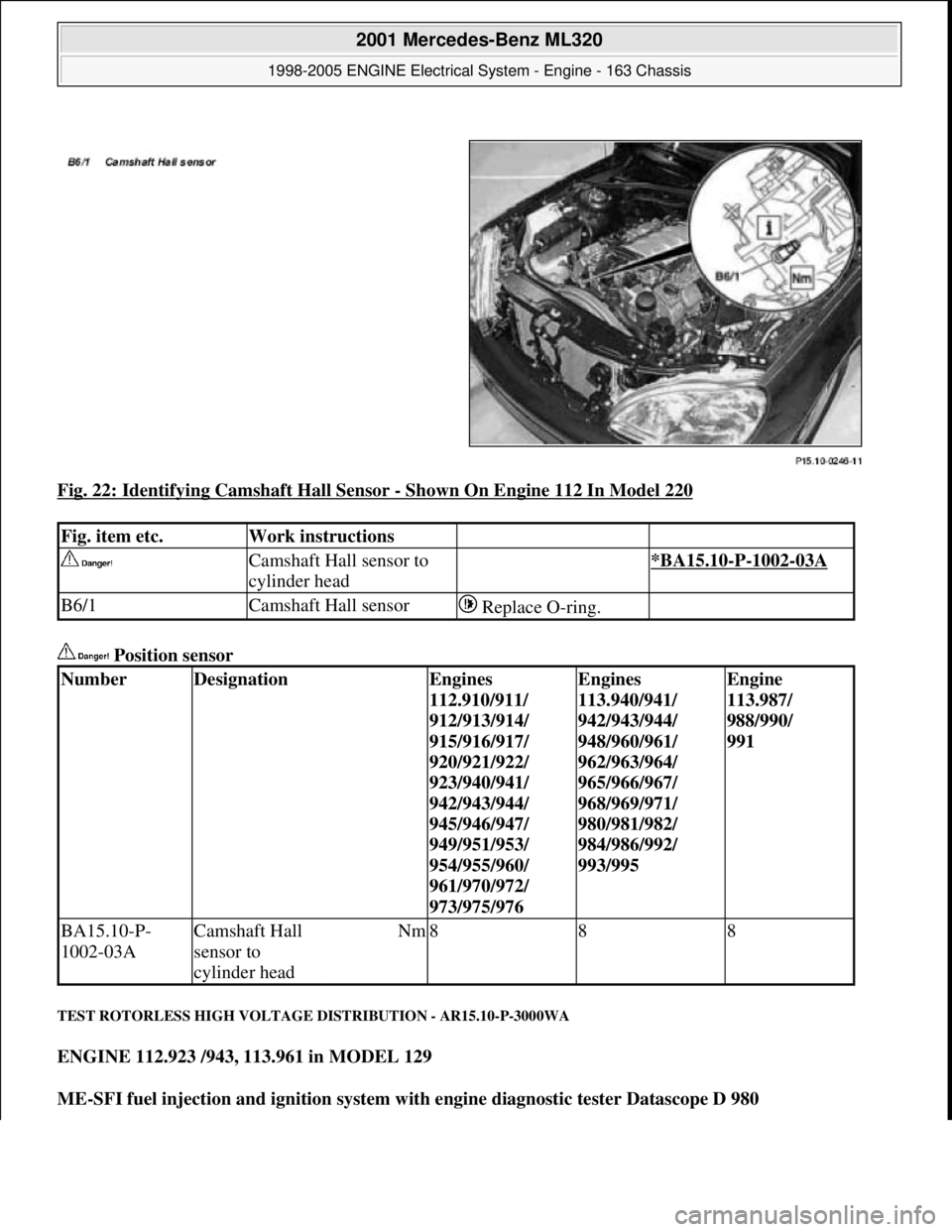
Fig. 22: Identifying Camshaft Hall Sensor - Shown On Engine 112 In Model 220
Position sensor
TEST ROTORLESS HIGH VOLTAGE DISTRIBUTION - AR15.10-P-3000WA
ENGINE 112.923 /943, 113.961 in MODEL 129
ME-SFI fuel injection and ignition system with engine diagnostic tester Datascope D 980
Fig. item etc.Work instructions
Camshaft Hall sensor to
cylinder head *BA15.10-P-1002-03A
B6/1Camshaft Hall sensor Replace O-ring.
NumberDesignationEngines
112.910/911/
912/913/914/
915/916/917/
920/921/922/
923/940/941/
942/943/944/
945/946/947/
949/951/953/
954/955/960/
961/970/972/
973/975/976Engines
113.940/941/
942/943/944/
948/960/961/
962/963/964/
965/966/967/
968/969/971/
980/981/982/
984/986/992/
993/995Engine
113.987/
988/990/
991
BA15.10-P-
1002-03ACamshaft Hall
sensor to
cylinder headNm888
2001 Mercedes-Benz ML320
1998-2005 ENGINE Electrical System - Engine - 163 Chassis
me
Saturday, October 02, 2010 3:18:54 PMPage 33 © 2006 Mitchell Repair Information Company, LLC.
Page 2188 of 4133
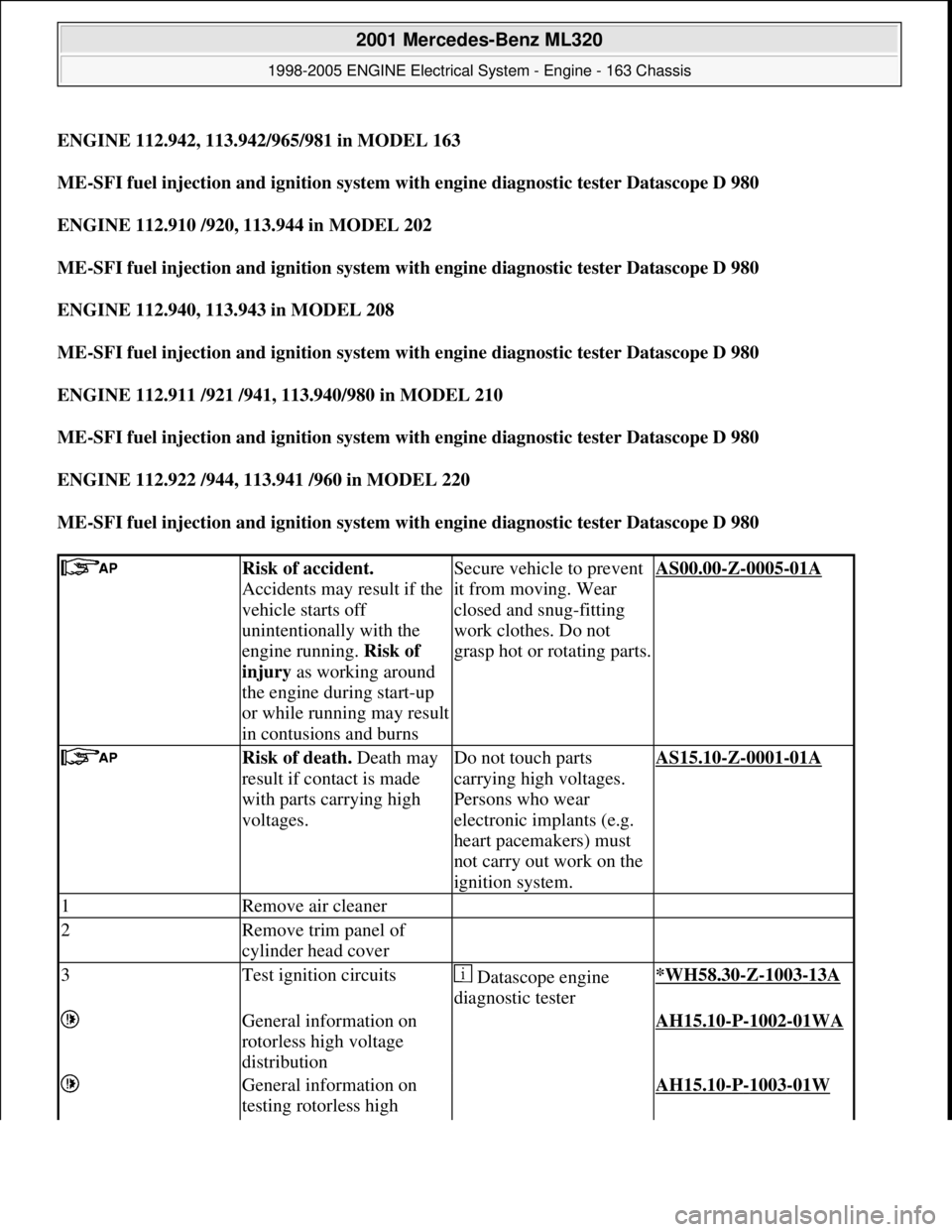
ENGINE 112.942, 113.942/965/981 in MODEL 163
ME-SFI fuel injection and ignition system with engine diagnostic tester Datascope D 980
ENGINE 112.910 /920, 113.944 in MODEL 202
ME-SFI fuel injection and ignition system with engine diagnostic tester Datascope D 980
ENGINE 112.940, 113.943 in MODEL 208
ME-SFI fuel injection and ignition system with engine diagnostic tester Datascope D 980
ENGINE 112.911 /921 /941, 113.940/980 in MODEL 210
ME-SFI fuel injection and ignition system with engine diagnostic tester Datascope D 980
ENGINE 112.922 /944, 113.941 /960 in MODEL 220
ME-SFI fuel injection and ignition system with engine diagnostic tester Datascope D 980
Risk of accident.
Accidents may result if the
vehicle starts off
unintentionally with the
engine running. Risk of
injury as working around
the engine during start-up
or while running may result
in contusions and burnsSecure vehicle to prevent
it from moving. Wear
closed and snug-fitting
work clothes. Do not
grasp hot or rotating parts.AS00.00-Z-0005-01A
Risk of death. Death may
result if contact is made
with parts carrying high
voltages.Do not touch parts
carrying high voltages.
Persons who wear
electronic implants (e.g.
heart pacemakers) must
not carry out work on the
ignition system.AS15.10-Z-0001-01A
1Remove air cleaner
2Remove trim panel of
cylinder head cover
3Test ignition circuits Datascope engine
diagnostic tester*WH58.30-Z-1003-13A
General information on
rotorless high voltage
distribution AH15.10-P-1002-01WA
General information on
testing rotorless high AH15.10-P-1003-01W
2001 Mercedes-Benz ML320
1998-2005 ENGINE Electrical System - Engine - 163 Chassis
me
Saturday, October 02, 2010 3:18:54 PMPage 34 © 2006 Mitchell Repair Information Company, LLC.
Page 2189 of 4133

Commercially available tools
REMOVE/INSTALL IGNITION COILS - AR15.12-P-2003A
ENGINE 112.910 in MODELS 202.026 /086
ENGINE 112.920 in MODELS 202.029 /089
ENGINE 112.921 in MODELS 210.063 /081 /263 /281
ENGINE 112.922 in MODELS 220.063 /163
ENGINE 112.923 in MODEL 129.059
ENGINE 112.940 in MODELS 208.365 /465
ENGINE 112.941 in MODELS 210.065 /082 /265 /282
ENGINE 112.942 in MODEL 163.154
ENGINE 112.943 in MODEL 129.064
ENGINE 112.944 in MODELS 220.065 /165
ENGINE 112.945 in MODEL 463
ENGINE 113.940 in MODELS 210.070 /270
ENGINE 113.941 in MODELS 220.070 /170
voltage distribution
if necessary: ?
Test secondary side
Secondary adapter
cable in place of kV
clamp.
kV clamp in ignition
coil recess alternately at
ignition coil T1/1-T1/6 or
T1/8
Test primary side
Primary adapter cable
alternatively at ignition
coil T1/1-T1/6 or T1/8
NumberDesignation
WH58.30-Z-1003-13AEngine tester
2001 Mercedes-Benz ML320
1998-2005 ENGINE Electrical System - Engine - 163 Chassis
me
Saturday, October 02, 2010 3:18:54 PMPage 35 © 2006 Mitchell Repair Information Company, LLC.